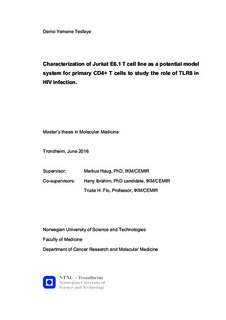| dc.description.abstract | HIV infects and destroys cells of the immune system such as macrophages, dendritic cells and CD4+ T helper cells. One route of HIV transmission is through cell-to-cell viral trans-infection where viral particles can be endocytosed by CD4+ T cells or other cell types and enter the endolysosmal degradation pathway. As other cells of the immune system, CD4+ T cells have been indicated to possess endosomal pattern recognition receptors (PRRs) such as Toll like receptors (TLRs), which might sense viral nucleic acids from these endocytosed HIV particles. Little is known today about the function of endosomal TLRs in CD4+ T cells. Preliminary findings in our group show that primary CD4+ T cells respond to endosomal TLR8 stimulation with inflammatory signaling. To further investigate the molecular mechanisms of TLR8 signaling in CD4+ T cells, it would be of great tool to have a suitable T cell line model system with defined TLR8 expression pattern. The human CD4+ T cell lymphoma cell line Jurkat E6.1 is a widely used T cell line to study molecular mechanisms in T cells. The aims of this project were therefore to characterize the Jurkat E6.1 cell line for their suitability as a model to study TLR8 signaling in CD4+ T cells. These include, analysis of Jurkat cells for their endosomal TLR expression as well as their cytokine and activation marker response upon endosomal TLR and T cell receptor (TCR) stimulation. The results obtained with Jurkat cells should then be compared to findings in primary CD4+ T cells. In addition, we aimed to develop Jurkat cell lines with defined TLR8 expression pattern by knocking-down or overexpressing TLR8 gene, with which the specific role of endosomal TLR8 in HIV infection of CD4+ T cells could be further investigated. We found that primary CD4+ T cells expressed TLR7, 8 and 9, while Jurkat cells expressed the genes for TLR7 and 9 but lacked TLR8 at both mRNA and protein level. The majority of Jurkat cells expressed the T cell co-receptor CD3 and the co-receptor for HIV entry CXCR4, while CD4+ expression was lower and greatly fluctuated. Similar to primary CD4+ T cells, Jurkat cells upregulated the activation markers CD69, CD40L and CD25 upon stimulation with T cell activators. However, in contrast to primary CD4+ T cells, the cytokine response profile of Jurkat cells was found to be very limited and mainly restricted to the secretion of IL-2, IL-8 and TNF. Jurkat cells did not respond to stimulation with TLR7, 8 and 9 ligands by means of cytokine production or activation marker upregulation. As Jurkat cells were found to lack TLR8, lentiviral transduction system and nucleofection methods were utilized to induce TLR8 expression. We found both methods to induce TLR8 II mRNA expression but TLR8 protein was not detected. Hence, we tested the possibility that undetected TLR8 protein might exert TLR8 function in the engineered Jurkat cells. However, stimulation with TLR8 ligand neither induced cytokine production nor triggered nuclear translocation of the transcription factor NF-κB both on the nucleofected and transduced Jurkat cells. In conclusion, we found that Jurkat cells do express endosomal TLR7 and TLR9 but lack TLR8. Successful expression of functional TLR8 protein in Jurkat cells was not achieved after repeated trials using two approaches. Use of alternative protocols and expression vectors may potentially lead to successful expression of functional TLR8 protein in Jurkat cells in future experiments. However, since it appeared difficult to introduce functional TLR8 into Jurkat cell and functional responses were not apparent for TLR7 and TLR9 stimulation, it might be considered to rather continue working with other T cell lines or directly with human primary CD4+ T cells. Primary CD4+ T cells are more difficult to modify than cell lines, but studies have succeeded and protocols are available. Knockdown of TLR8 in primary CD4+ T cells could then directly proof the importance of TLR8 signaling in CD4+ T cells and a possible role for TLR8 in CD4+ T cells during HIV infection. | nb_NO |
